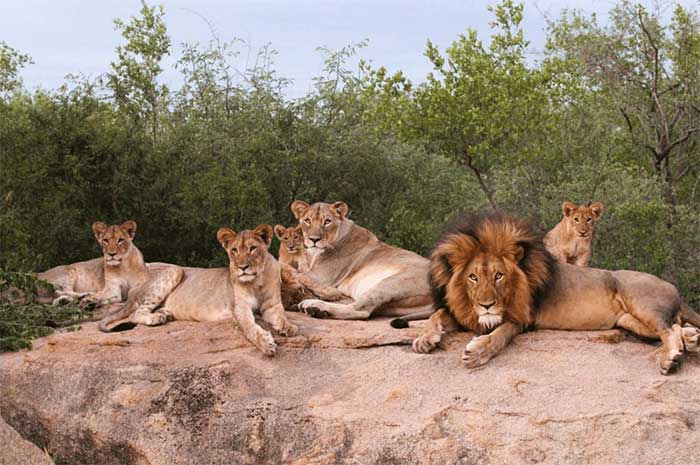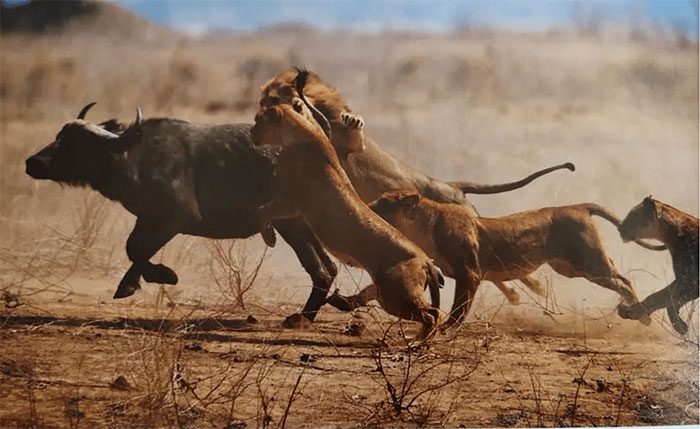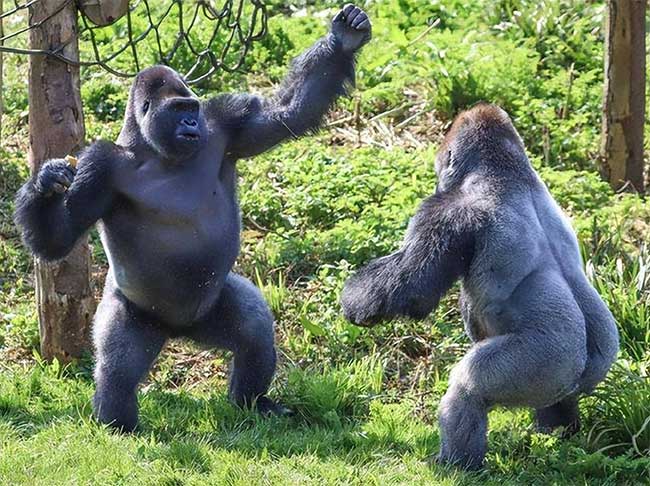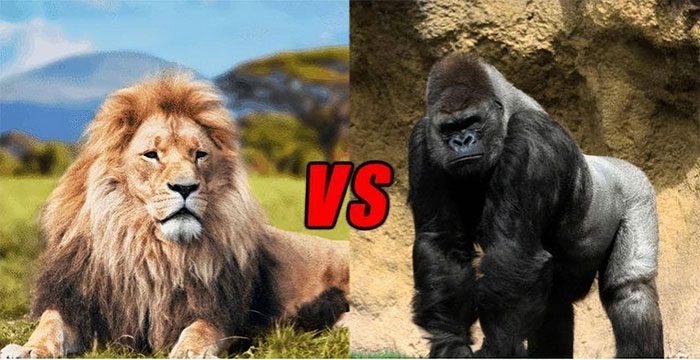Lions are known as the “kings of the savannah.” They are apex predators in the vast grasslands of Africa.
Their prey includes antelope, buffalo, and even giant African elephants. However, in the complex food chain of the African wilderness, gorillas rarely become targets for lions.
So why do we hear so little about lions attacking gorillas? To answer this question, we first need to understand the characteristics and behaviors of both species.
1. The Behavior of the “King”
Lions primarily inhabit the vast savannas of sub-Saharan Africa. They are among the strongest cats on the African plains and are strictly carnivorous.

Lions typically live in groups like a family.
Lions have short, dense fur that is light gray and somewhat golden, which helps them camouflage while stalking prey. Their bodies are compact, with thick, powerful limbs, making them excellent runners and chasers. Their sharp claws are always ready to seize and tear apart their prey.
Their social structure is quite unique. They often live in groups known as prides. A pride typically consists of several generations of related females, at least one mature male, and a number of growing cubs with a strong territorial instinct. Their territorial behavior is highly developed, with each pride occupying a fixed territory of 8 to 30 lions.
Thanks to their social living, the cooperation rate for successful hunts among lions is very high. They are adept at teamwork and know how to select the most suitable hunting methods based on the characteristics of their prey and environmental conditions.
In the scorching African continent, they conserve energy by resting. When prey appears, they hunt with incredible speed and teamwork.

African buffalo is a common target for lions.
Each adult lion is a skilled hunter. Among them, the mature male lion plays a key role in hunting and is primarily responsible for tracking and ambushing prey. Meanwhile, other pride members maintain close coordination, staying alert, seeking the right moment, and striking vital parts of the prey with incredible speed.
After a meal, lions rest for a long time; their digestive systems need time to process their protein-rich meals. Thus, they spend most of the day resting in the shade to reduce energy expenditure and escape the heat.
During their resting period, cubs learn hunting skills, preparing for future high-speed hunts.
2. The Behavior of the “Closest Relatives to Humans”
Gorillas (Gorilla) are one of the closest living relatives to humans; both groups share a common ancestor that lived around 10 million years ago. Due to this shared ancestry in the evolutionary process, their genes are 98% similar to those of humans.
Although both have taken separate evolutionary paths, humans and gorillas still share many biological and behavioral traits, including complex social behaviors and unique communication methods.

Gorillas are one of the closest living relatives to humans.
Wild gorillas primarily inhabit dense forests in Uganda and the Democratic Republic of the Congo in East Africa, as well as in the Republic of the Congo, Gabon, Cameroon, Equatorial Guinea, and Nigeria in Central and West Africa.
The bodies of gorillas are covered with thick black fur, with wrinkled faces, deep-set eyes, protruding jaws, and well-developed canines. Adult males typically weigh between 130 to 180 kg and can reach a height of about 1.7 meters, while females weigh about half that.
Overall, this species is large and robust, possessing muscle strength that is five times greater than that of humans. They are excellent climbers, can walk upright, enjoy swinging from trees, and will beat their chests and roar to display their strength. Unlike lions, gorillas are omnivores, consuming grass, leaves, roots, fruits, and sometimes protein-rich foods like insects or ants.
Gorillas are diurnal and primarily terrestrial. They usually move on all fours, with some weight supported by their knuckles.
Gorillas are highly social animals, often forming groups that include one mature male, several females, and juvenile gorillas. The mature male gorilla is the leader of the group and is primarily responsible for protecting the group’s safety and maintaining order, including fending off other male gorillas to protect the entire troop from predators.
Intruders may face the large, fierce silverback leader. Displays of threat include chest beating, loud vocalizations, or charging towards the intruder.
Gorilla groups are not fixed, and young male gorillas may leave the group upon maturity to form their own or join other groups.
3. Do Lions Eat Gorillas?
The simple answer is NO or RARELY because lions and gorillas typically do not inhabit the same areas. Lions reside in vast savannas, while gorillas live in dense forests. Encounters between lions and gorillas are extremely rare.

Lions rarely hunt gorillas because they usually do not live in the same area.
The true enemies of gorillas are leopards, jaguars, and giant pythons.
In the rare event that they do cross paths, a mature male lion may attack a gorilla if it is alone, but this is also uncommon. Typically, lions prefer to hunt easier prey such as antelopes and zebras.
4. If Lions and Gorillas Fought, Who Would Win?
Given that the habitats and behaviors of lions and gorillas rarely “overlap,” what if we were to place both large males in a large enclosure? Who would emerge victorious?
To provide a relative answer to this scenario, let’s analyze the following points:
Size
An adult lion weighs between 130 kg and 250 kg, slightly heavier than an adult gorilla.
Speed
True to their title as the “King of the Savannah,” lions possess remarkable speed. They can run at speeds of 48 km/h (approximately 13 meters per second), which is faster than the quickest gorilla. Gorillas can run at speeds of 40 km/h (11 meters/second), but they may be vulnerable to attack while running.
Bite Force
Lions and gorillas use powerful bites to inflict damage on their adversaries during fights. Although lions are renowned as predators, their bite force is not as strong as many might think, averaging around 650 pounds per square inch (PSI), comparable to that of a large dog. The strongest bites reach 1000 PSI.
Gorillas can bite through and tear apart large trees with a bite force of up to 1300 pounds per square inch (PSI) — on average, double that of a lion. However, a lion’s teeth are longer and sharper than those of a gorilla, allowing them to target critical areas of their prey effectively.
Intelligence/Experience
Gorillas are more intelligent than many other animals. However, they may struggle to leverage their intelligence effectively in high-speed confrontations due to various challenges.
In a fight, they might throw objects at the lion, but that would likely have little effect. Lions are intelligent enough to strategize their attacks, waiting for the perfect moment to strike. While gorillas are intelligent, lions excel in utilizing their smarts to take down prey.
Summary: Overall Strength/Fighting Effectiveness
Gorillas can display remarkable self-defense and fighting skills when faced with threats. While a gorilla’s strength largely comes from its muscle mass (especially powerful arms) and bite force, a lion’s strength derives from its sharp jaws, formidable claws that can reach up to 4 cm, and its cunning in hunting.
In terms of combat experience, lions are abundant. Living in vast savanna environments, where food can be scarce, they must adapt and survive. Their fighting spirit and survival instincts are incredibly strong.
In contrast, gorillas primarily consume plant-based diets, focusing their daily activities on foraging and social interactions, lacking the hunting and confrontational experience of lions. Moreover, gorillas typically attack by pushing or striking their opponents with their hands. Therefore, in terms of fighting spirit and experience, gorillas are generally not as formidable as lions.
Based on the above analysis, lions are superior to gorillas and would likely win in a confrontation between the two species. Of course, in reality, it’s difficult to determine who would truly prevail.
Nevertheless, lions are wise enough to avoid hunting gorillas due to their formidable strength. Instead, the “kings of the savannah” focus their efforts on easier and more common prey.





















































